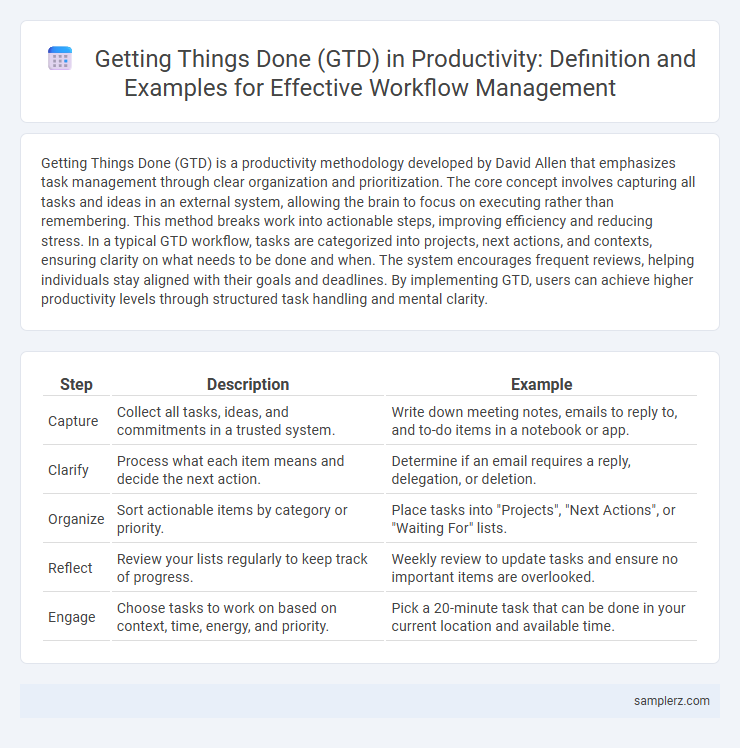Getting Things Done (GTD) is a productivity methodology developed by David Allen that emphasizes task management through clear organization and prioritization. The core concept involves capturing all tasks and ideas in an external system, allowing the brain to focus on executing rather than remembering. This method breaks work into actionable steps, improving efficiency and reducing stress. In a typical GTD workflow, tasks are categorized into projects, next actions, and contexts, ensuring clarity on what needs to be done and when. The system encourages frequent reviews, helping individuals stay aligned with their goals and deadlines. By implementing GTD, users can achieve higher productivity levels through structured task handling and mental clarity.
Table of Comparison
| Step | Description | Example |
|---|---|---|
| Capture | Collect all tasks, ideas, and commitments in a trusted system. | Write down meeting notes, emails to reply to, and to-do items in a notebook or app. |
| Clarify | Process what each item means and decide the next action. | Determine if an email requires a reply, delegation, or deletion. |
| Organize | Sort actionable items by category or priority. | Place tasks into "Projects", "Next Actions", or "Waiting For" lists. |
| Reflect | Review your lists regularly to keep track of progress. | Weekly review to update tasks and ensure no important items are overlooked. |
| Engage | Choose tasks to work on based on context, time, energy, and priority. | Pick a 20-minute task that can be done in your current location and available time. |
Introduction: What is Getting Things Done (GTD) in Productivity?
Getting Things Done (GTD) is a productivity methodology developed by David Allen that emphasizes capturing, clarifying, organizing, reflecting, and engaging with tasks and projects efficiently. GTD helps individuals reduce mental clutter by systematically processing commitments into actionable items, enabling clearer focus and increased output. This approach leverages tools like to-do lists, calendars, and project plans to enhance time management and goal achievement.
Key Principles of the GTD System
The Getting Things Done (GTD) system emphasizes capturing all tasks and ideas into a trusted external system to clear mental clutter and increase focus. It advocates clarifying actionable steps, organizing tasks by context, priority, and deadlines, and regularly reviewing commitments to maintain clarity and control. Implementing GTD's five phases--capture, clarify, organize, reflect, and engage--streamlines workflow and boosts overall productivity.
Setting Up Your GTD Workflow Step-by-Step
Setting up your GTD workflow step-by-step begins with capturing all tasks and ideas in a trusted inbox to clear mental clutter. Next, clarify each item by deciding actionable steps and organizing them into context-specific lists such as Projects, Next Actions, and Waiting For. Consistently reviewing and updating these lists ensures effective focus and progress in your productivity system.
Capturing Tasks: The First Action in GTD
Capturing tasks in Getting Things Done (GTD) involves collecting all actionable items into a trusted system to clear mental clutter and ensure nothing is overlooked. Using tools like notebooks, digital apps, or voice memos, individuals record tasks immediately upon identification for efficient processing. This crucial first step enhances focus, reduces stress, and lays the foundation for organized task management and improved productivity.
Clarifying and Organizing Your To-Do List
Clarifying and organizing your to-do list enhances productivity by breaking down tasks into actionable steps, ensuring each item is specific and manageable. Using David Allen's Getting Things Done (GTD) method, categorize tasks into contexts and priorities to streamline focus and reduce decision fatigue. This approach transforms cluttered lists into clear, organized workflows that drive consistent progress.
Reviewing Regularly for Enhanced Focus
Reviewing regularly in the Getting Things Done (GTD) methodology ensures tasks and projects stay aligned with current goals, preventing overwhelm and enhancing focus. Weekly reviews help clear mental clutter by updating lists, prioritizing actions, and reflecting on progress, which sharpens attention on what truly matters. This disciplined cycle of review fosters sustained productivity and greater clarity in task management.
Examples of GTD Tools and Apps for Productivity
Getting Things Done (GTD) methodology enhances productivity through tools like Todoist, which organizes tasks with priority levels and due dates, and Trello, which uses boards and cards for project visualization. Microsoft OneNote facilitates capturing and categorizing ideas seamlessly, while Evernote supports collecting notes and checklists accessible across devices. These GTD apps optimize workflow, task management, and project tracking for effective productivity improvements.
Applying GTD to Workplace Projects
Applying Getting Things Done (GTD) to workplace projects enhances productivity by breaking tasks into actionable steps and prioritizing clear next actions. Organizing project workloads through GTD's five stages--capture, clarify, organize, reflect, and engage--ensures consistent focus and progress. This methodology reduces overwhelm, improves task tracking, and boosts team collaboration on complex assignments.
Real-Life Success Stories Using GTD
David Allen's Getting Things Done (GTD) methodology has transformed productivity for millions, including high-profile entrepreneurs like Jeff Bezos, who credits GTD with enhancing his task management and decision-making efficiency. Real-life success stories reveal individuals leveraging GTD to streamline workflows, reduce stress, and achieve consistent project completion by breaking down tasks into actionable steps. This disciplined approach fosters clarity and control, enabling professionals to maintain focus on priorities and deliver tangible results.
Tips for Sustaining GTD Habits Long-Term
Consistently reviewing your GTD lists and calendars ensures tasks remain relevant and prioritized, preventing backlog accumulation. Establishing daily or weekly rituals, such as morning planning or end-of-day reflection, reinforces habit formation and keeps your workflow organized. Utilizing digital tools with reminders and seamless syncing supports maintaining momentum and accountability in your productivity system.

example of Getting Things Done in productivity Infographic
 samplerz.com
samplerz.com